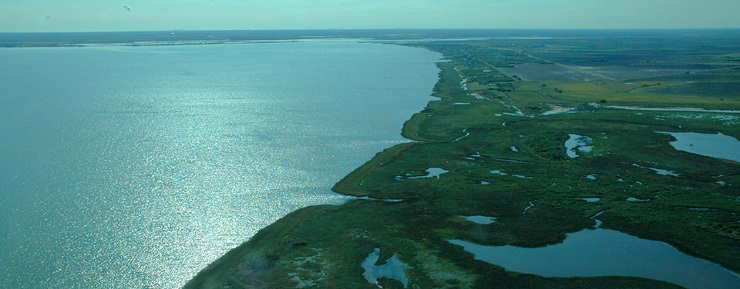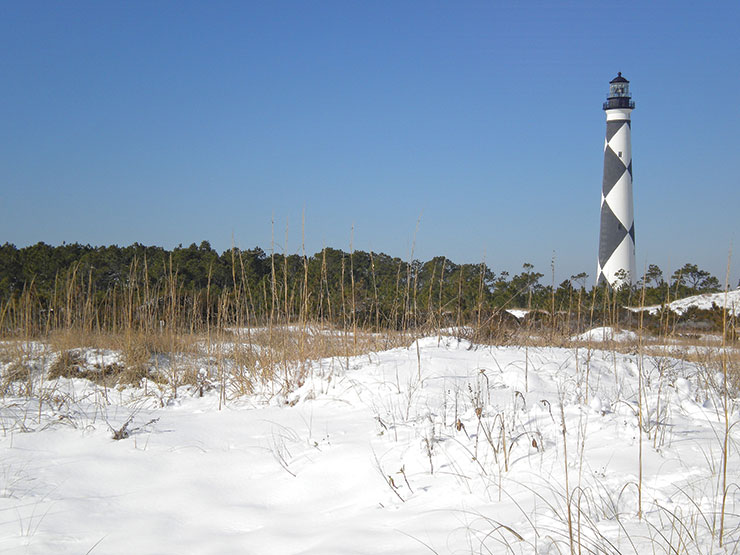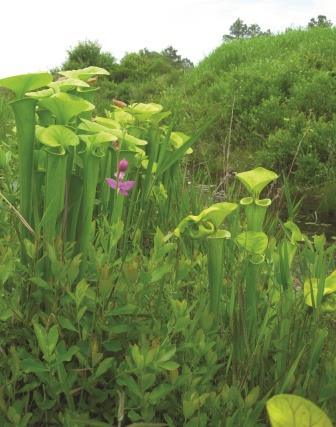Science Serving the Coast: Specter of Oil Spurs Research Response

“There has been a collective effort to bring the best available science and technology to bear on dealing with the massive spill and its impacts on the states bordering the Gulf of Mexico. And South Atlantic states also have been on watch for the limited potential of impacts here.” — Michael Voiland, Executive Director of North Carolina Sea Grant
For months, eyes were fixed on efforts to permanently stop the flow of oil spewing into the Gulf of Mexico from the ruptured Deepwater Horizon rig.
Now, the struggle continues as researchers from across the nation try to assess and, if necessary and possible, to mitigate adverse effects on ecosystems, livelihoods and communities of the region.
“There has been a collective effort to bring the best available science and technology to bear on dealing with the massive spill and its impacts on the states bordering the Gulf of Mexico,” says Michael Voiland, executive director of North Carolina Sea Grant. “And South Atlantic states also have been on watch for the limited potential of impacts here.”
Early on, representatives from Sea Grant College Programs in the South Atlantic states convened summits with university researchers and National Oceanic and Atmospheric Administration (NOAA) partners to discuss implications for North Carolina, South Carolina, Georgia and Florida.

At one meeting, physical oceanographers appraised the potential for the Deepwater Horizon oil reaching South Atlantic coastal waters via the Loop Current and Gulf Stream “conveyor belt.” At another, petrochemical and chemical oceanographers discussed what forms oil from the spill might take if any would reach the Atlantic shores.
Scientists say it’s difficult to predict if and when some portion of the oil- and dispersant-contaminated water might enter the Loop Current. That’s because its location is highly variable, according to summit participant Ruoying He, an oceanographer who heads the Ocean Observing and Modeling Group at North Carolina State University.
The good news is that a clockwise circular current known as an eddy spun off from the Loop Current in mid-May, thus blocking the surface oil slick from Deepwater Horizon from attaching to the Loop Current. The longer the oil stayed in the Gulf and the eddy — dubbed Eddy Franklin — the more degraded and less toxic it became, according to He.
He has been studying currents in the Gulf of Mexico and the South Atlantic for nearly a decade. His NC State group is one of several teams running ocean circulation forecast models for NOAA. Now, grants from the National Science Foundation Rapid Response Research program and North Carolina Sea Grant will enable the scientists to continue their timely research.
They are developing and testing a three-dimensional oil tracer model that is running together with their ocean circulation model. “We hope to use this model to simulate the transport of the oil plume both at the ocean surface and at depths. The time-and-space continuous model fields can then be used to fill the observational gaps and provide a more comprehensive picture of oil plume distributions,” He says.
One obstacle is that scientists can provide little data on how dispersants change the oil properties at depths of 5,000 feet below the ocean surface. “We and some of our colleagues are working together to improve our understanding of this process so we can better build it into the model,” He explains.
How might the coming tropical storm season impact ocean circulation, including Eddy Franklin, in the Gulf region?
“It depends on how strong the storm is and how quickly it moves over the eddy,” He explains. “The stronger the storm is and the slower it moves, the larger its impact on changing the characteristics of an ocean eddy.”
High winds and seas induced by tropical storms likely will mix and weather the oil, thus accelerating the oil biodegradation process. On the other hand, storm surges may carry oil and dispersants into the Gulf coastline, He observes.
A project funded by the Office of Naval Research also will help He and his colleagues study interactions between the eddy and hurricanes.
BE PREPARED AND FLEXIBLE
While there appears to be only a small risk that Gulf-spill oil would reach the North Carolina shores, researchers here are taking proactive measures to establish baseline scientific data that could be used to document “before and after” effects of oil residues that may make it to nearshore waters or shorelines — be it from the Deepwater Horizon or an offshore tanker mishap.
Researchers from the University of North Carolina Wilmington were preparing for scheduled post-beach nourishment biological sampling exercises along beaches in New Hanover County when the Gulf oil spill occurred. The multidisciplinary team adjusted their already rigorous schedules to collect separate samples of ocean water, sediment, shellfish and fish.
Their work will provide baseline scientific data of what an oil-free, ecologically healthy beach looks like, according to Lawrence B. Cahoon, who leads the research team. The extra samplings and analyses follow federally designed forensic Natural Resource Damage Assessment (NRDA) protocols to detect oil pollution.
The initiative builds on the UNCW researchers’ two-year biological study, funded by North Carolina Sea Grant, of how beaches are impacted by and how marine organisms respond to beach nourishment or other human activities.
Additional North Carolina Sea Grant “mini-grant” support is enabling the UNCW team to conduct scientific baseline NRDA sampling for hydrocarbons from Brunswick County at the North Carolina/South Carolina border to Cape Hatteras.
Should oil from Deepwater Horizon come ashore in any form, scientists anticipate its unique chemical “fingerprint” will distinguish it from other random sources. Crude oil is a complex mix of hydrocarbons and heavy metals associated with a specific source, Cahoon explains.
The UNCW research team includes:
Cahoon, a biological oceanographer focusing on phytoplankton and sediment microbe dynamics; Thomas Lankford, a marine biologist and ichthyologist focusing on fish population abundance and health in the surf zone; Martin Posey, department chair of biology and marine biology focusing on marine bottom animal communities and food web structure; Troy Alphin, a benthic ecologist focusing on collection and lab analysis of marine bottom communities; and Lynn Leonard, department chair of geography and geology focusing on sediments and beach topographic profiles.
Voiland is pleased that Sea Grant can make such rapid research investment decisions to help the state deal with potential oil spill arrival and resulting impacts.
“Being co-funded with state and federal resources, understanding university research procedures, and working hard to discern emerging coastal research needs in the state, Sea Grant can be flexible and timely with regard to the research information it seeks. We can use project extensions and other means to help focus or amplify university faculty research efforts,” he notes.
WET AND WILD TEACHABLE MOMENTS
Working conditions can be wet and unpredictable and require adaptability — not unlike the marine life they are studying, says Amanda Kahn, who based her doctoral work at UNCW on a NOAA-funded sea grass study. Now teaching at the University of North Florida, Kahn returned to UNCW to conduct post-doctoral studies on the summer round of post-beach nourishment sampling, specifically on the surf-zone phytoplankton.

Kahn and research assistant Chad McPeters are focusing on the intertidal zone runnels — shallow, sandy bottom channels created by tidal currents. The calmer waters in runnels appear to be important areas for young fish to save energy for growth, to find abundant food, and to be protected from predators.
So Kahn and McPeters are looking at water column samples to measure the seasonal abundance and community structure of phytoplankton and how well these microscopic marine plants are using light for photosynthesis, and in turn, the production of chlorophyll. Phytoplankton species are the foundation of the marine food chain.
A bit of MacGyver innovation was required to adapt some instruments that usually are used for open-ocean and deep-water sample collection rather than for their inshore studies, Kahn says.
“We draw curious onlookers on the beach when we show up with our cumbersome gear and start dragging it through the surf. We regard explaining our activities as teachable moments to raise awareness — and to keep swimmers and surfers from getting entangled in our instruments,” she adds.
FACING THE FUTURE
The Deepwater Horizon catastrophe has decision makers, the general public and even scientists looking at coasts in different ways — from renewed appreciation for coastal resources to renewing emergency disaster response plans to protect coastlines.
The State of North Carolina already has updated its response plan that names the Emergency Management Division of the Department of Crime Control and Public Safety as the lead agency in response to potential oil events. The N.C. Department of Environment and Natural Resources is to be the lead technical advisory group. These agencies are working with the U.S. Coast Guard and the U.S. Environmental Protection Agency to coordinate the state’s plan with federal response plans.

As Sea Grant director, Voiland participated in a meeting of the State Emergency Response Team, and was asked to present summit findings at a regional meeting hosted by U.S. Rep. Mike Mclntyre. “Our state and federal partners appreciate Sea Grant’s unique role — working with top scientists while also providing the research results in terms that the public can understand,” Voiland explains.
Overall, the state has a vast realm of researchers. “Higher education will continue to play a critical role in how this crisis and future disasters play out,” says Robert Roer, dean of UNCW Graduate School and Research. “We must maintain an ongoing dialogue with state, federal and local agencies to help make them aware of the wealth of expertise located at institutions of higher education.”
Roer encouraged a dialogue through a workshop with researchers from across the UNC system and representatives from federal and state agencies to highlight available technologies and scientific information. Another group met at UNC Chapel Hill to discuss the resources to deal with the human health implications of any potential spill off the North Carolina coast. Still another regional gathering took place at Coastal Carolina University in Conway, S.C., where attendees discussed the economic potential of alternative energy.
Some scientists see reason for optimism and hope. “The Gulf accident may be a tipping point. Sputnik was a landmark event in the ’50s that ushered in an emphasis on science and math education. This may be another landmark event that ushers in change. It comes at a time of converging issues — energy, climate change and sea level rise,” points out UNCW marine biologist Martin Posey.
“Change will require more collaborative innovation on the part of universities as well as industry — and that can be a good thing.” — P.S.
North Carolina Sea Grant developed the N.C. Oil Watch page online to highlight research and other updates. It includes links to the NC State team and details on the UNCW research, as well as the summit summaries and contact pages for various state and federal agencies. Go to: http://ncseagrant.org/s/GulfOilWatch.
This article was published in the Autumn 2010 issue of Coastwatch.
For contact information and reprint requests, visit ncseagrant.ncsu.edu/coastwatch/contact/.
- Categories:


